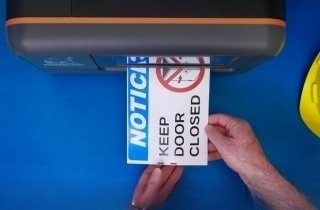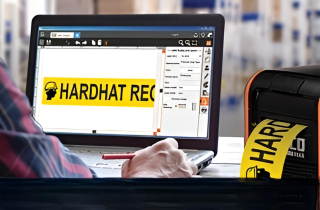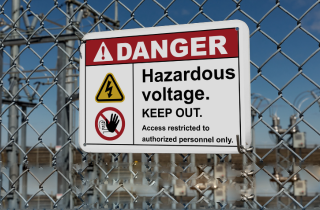How OSHA 1910.145 Defines Workplace Safety Signs and Tags

Every workplace has hazards, from heavy machinery and electrical risks to chemical exposure and biological threats. Without clear warnings, workers may overlook dangers, leading to serious injuries, illnesses, or even fatalities. Safety signs and tags are an essential part of workplace communication, helping prevent accidents and maintain compliance with regulatory standards.
OSHA’s 29 CFR 1910.145 establishes clear requirements for safety signage, specifying how hazards should be communicated to workers. Whether in manufacturing, construction, healthcare, or any other industry, following OSHA’s sign and tag requirements helps protect employees while reducing employer liability.
Why OSHA 1910.145 Matters for Workplace Safety
OSHA created the 1910.145 standard to ensure that all safety signs and tags provide clear, consistent warnings. Proper signage prevents confusion and misinterpretation, reducing the likelihood of workplace injuries and fatalities. Compliance with OSHA standards also helps businesses avoid costly fines and legal issues.
Beyond regulatory adherence, businesses that invest in effective safety signage foster a culture of awareness and accountability. When employees can easily recognize hazards, they are more likely to follow safe work practices, leading to fewer accidents and disruptions.
Key benefits of OSHA-compliant signage include:
-
Reduced Workplace Accidents: Clear warnings help workers identify and avoid hazards before incidents occur.
- Regulatory Compliance: Meeting OSHA standards helps businesses pass inspections and avoid penalties.
- Improved Productivity: A safer work environment means fewer disruptions due to accidents and investigations.
- Legal and Financial Protection: Proper signage demonstrates due diligence, protecting companies from liability claims.
OSHA 1910.145 and ANSI Z535 Safety Standards
When OSHA first introduced its signage regulations, they were based on the ANSI Z35.1-1968 standard, which provided a widely recognized framework for workplace safety signs. Over time, ANSI developed the Z535 series, which introduced more detailed guidelines on color coding, symbols, and formatting.
OSHA’s regulations remain the primary legal requirement for safety signage, but in 2013, OSHA clarified that employers could use either the original OSHA-compliant designs or the ANSI Z535 formats, giving workplaces flexibility in choosing an approach that meets their needs.
Key Differences Between OSHA 1910.145 and ANSI Z535
| Feature | OSHA 1910.45 | ANSI Z535 |
| Color Coding | Basic guidelines | Specific colors assigned to each hazard level |
| Pictograms | Limited guidance | Standardized symbols for clarity |
| Header Formats | Text-based warnings | Bold, color-coded headers (e.g., Danger: Red, Warning: Orange) |
| Font Requirements | Readable lettering | Defined font sizes for better visibility |
Both standards are acceptable under OSHA regulations, allowing businesses to select the signage format that best fits their operational requirements.
Best Practices for Safety Signage Placement and Visibility
Placing safety signs correctly is just as important as selecting the right design. A sign that isn’t clearly visible or strategically positioned won’t be effective in preventing accidents.
Follow these best practices to maximize the impact of safety signage:
-
Ensure Unobstructed Visibility: Signs should be placed at eye level and in locations where they are immediately noticeable.
-
Use Consistent Placement: Similar hazard signs should be positioned uniformly throughout a facility to create familiarity.
-
Consider Lighting Conditions: Signs should be illuminated or have reflective properties in low-light environments.
-
Inspect and Maintain Signs Regularly: Faded, damaged, or obstructed signs should be replaced immediately.
-
Use Multilingual or Symbol-Based Signs When Needed: In workplaces with diverse language speakers, pictograms or bilingual signs improve comprehension.
By following these guidelines, businesses can enhance safety communication and minimize workplace hazards.
Danger Signs
"Danger" signs identify the most serious workplace hazards, indicating that failure to avoid them may result in severe injury or death. OSHA requires that these signs clearly communicate immediate danger and outline all necessary precautions. When multiple signs warn about the same or similar hazards within a facility, they should maintain a consistent design to ensure uniformity and recognition.
Caution Signs
"Caution" signs alert workers to potential hazards that could result in minor or moderate injuries if not avoided. According to OSHA, these signs should clearly identify potential dangers or unsafe work practices while advising workers on the necessary precautions. In many cases, "Caution" signs may include instructions such as the use of personal protective equipment (PPE) to minimize risk.
Safety Instruction Signs
Safety instruction signs usually convey general messages, most commonly concerning health, first aid, medical equipment, housekeeping, sanitation, and general safety measures. OSHA's standard states that safety signs should offer general instructions and suggestions for safety measures. For instance, these signs may point out emergency eye wash fountains and first aid kits.
Biological Hazard Signs
Biological hazard signs communicate the presence or potential presence of biohazards, helping workers identify contaminated equipment, rooms, or materials. While OSHA’s standard provides minimal design requirements, these signs must include the biohazard symbol, which may be black or orange. A background color is optional but, if used, must provide sufficient contrast for clear visibility. In some cases, "Danger" or "Warning" signs may also be used to highlight biohazard risks.
General Sign Design Elements
29 CFR 1910.145 outlines general design elements. Here are a few rules to consider when selecting safety signs:
- Rounded or Blunt Corners: Signs must have rounded or blunt corners and be free from sharp edges, burrs, splinters, or other sharp projections.
-
Safe Fastening: Fastening devices should be positioned so they do not constitute a hazard.
-
Legible Wording: Words on signs must be easy to read, accurate, clear, and concise.
-
Adequate Information: Signs must contain enough information to be easily and quickly understood.
Guidelines for Accident Prevention Tags
Employers may occasionally use tags, in lieu of signs, for addressing temporary, unexpected, or unapparent hazards (such as when performing lockout/tagout procedures on a piece of equipment). Accident prevention tags are usually used temporarily-only until the hazard in question has been eliminated, or until the hazardous operation has wrapped up.
Here are a few guidelines for using accident prevention tags, as laid out in 29 CFR 1910.145(f):
- Tags should contain a signal word (such as "Danger," "Caution" or "Biological Hazard"), which should be readable from at least five feet away (or longer, if warranted by the hazard)
- The tag's primary message should communicate the specific hazard or provide instruction for remaining safe
- Tags may use symbols, text, or a combination of the two
- All visual communication must be understandable to all employees exposed to the hazard
- Tags should be affixed as close as safely possible to the hazard through wire, string, or adhesive
DuraLabel Resources for Accident Prevention Safety Signs and Tags
Maintaining clear and effective safety signage is essential for protecting workers and meeting OSHA requirements. DuraLabel provides durable labels and signs designed to withstand industrial environments, ensuring long-term compliance with OSHA 1910.145 and ANSI Z535 standards.
Partnering with DuraLabel provides access to LabelForge PRO, a powerful custom labeling software pre-installed on DuraLabel Industrial Sign and Label Print Systems. This free, intuitive software simplifies OSHA-compliant sign and tag creation with built-in templates, customization tools, and an extensive library of safety symbols. Whether you need durable signs for long-term facility hazards or temporary accident prevention tags, LabelForge PRO streamlines the process—saving time while ensuring regulatory compliance.
Learn more about compliant safety signage with the OSHA Signage Quick Start Guide. Download the guide today to simplify OSHA compliance and improve safety in your facility! Contact us at 1-888-789-9790 to speak with a safety professional about your signage needs.
Read Next:
DIY Labels or Premium Vinyl? Choosing the Right Safety Signs
Related Resources

OSHA Confined Space
OSHA Confined Space Safety OSHA's regulation 29 CFR 1910.146 covers "permit-required confined spaces." This ...
Read
Understanding OSHA's 1910 120 (HAZWOPER) Requirements
OSHA is not involved in regulating hazardous waste. However, they are concerned about the safety of workers ...
Read
Confined Spaces: How to Satisfy OSHA Compliance
While many may think of any small area as a confined space, the Occupational Safety and Health Administration ...
Read.png)







